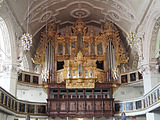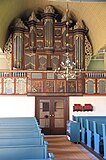Berendt Hus
Berendt Hus (* around 1630; † February 1676 ) was a German organ builder .
life and work
Hus was born around 1630 and probably came from the city of Oldenburg or the Oldenburger Land , where the family name was often encountered. The earliest evidence of Hus is his activity in Langwarden in 1650 , where he and his teacher Hermann Kröger created a two-manual work. Shortly after the new organ was built in the St. Marien town church in Celle , where he worked as Kröger's journeyman on the prospectus in 1653 , Hus started his own business as an organ builder. In 1654 he married "Maria Fritzschen" in Oldenburg and became a citizen of the city. Baptisms of four children are recorded between 1656 and 1671. The new building in Diepholz in the years 1655–1656 is considered the first independent activity.
Hus achieved his greatest fame because he was the uncle and teacher of the legendary organ builder Arp Schnitger . From 1666 to 1671, Schnitger learned organ building from Hus. Together with him he expanded the two-manual Hus organ of the town church Glückstadt (1661-1666) with a breastwork. Schnitger's share in the famous organ of St. Cosmae et Damiani (Stade) , which he completed after the death of his master, was even greater . The Kröger / Hus organ in Langwarden was preserved from profound changes and is still largely original (14 of 21 registers ). Schnitger built 1704/05 stronger concoctions and reeds one, but fell a conversion action in the 19th century to the victim.
Berendt Hus created a total of eight new organs and also carried out modifications and many repairs.
Proven works
| year | place | church | image | Manuals | register | Remarks |
|---|---|---|---|---|---|---|
| 1650 | Langwarden | St. Laurence |

|
II / P | 21st | Collaboration with Hermann Kröger; Organ largely preserved |
| 1653 | Celle | City Church of St. Mary | III / P | 35 | Collaboration on the prospectus that has been received; Rowan West's pipework reconstructed (today III / P / 49) | |
| 1655-1656 | Diepholz | City Church | II / P | 16 | ||
| 1658-1659 | Milk shrimps | St. Marien and Pankratius | II / p | 17th | In 1857 the Haupt brothers added an independent pedal (II / P / 22) | |
| 1658-1660 | Eckwarden | St. Lamberti | II / p | Overhaul of the organ | ||
| 1661-1665 | Glückstadt | City Church Glückstadt |

|
II / P | 27 | 1674–1675 by Hus and Schnitger extension by a breastwork; Prospectus in St. Nikolai (Castle on Fehmarn) received (photo) |
| 1667 | jade | Trinity Church | I / p | 11 | Attribution | |
| 1668-1673 | Stade | St. Cosmae et Damiani (Stade) |

|
III / P | 42 | Completed by Arp Schnitger; largely preserved → organ from St. Cosmae et Damiani (Stade) |
| 1673 | Sandstedt | Ev.-luth. church | II / P | 16 | Prospectus received (pipework from Gebr. Hillebrand , Alfred Führer ) | |
| 1673-1676 | Stade | St. Wilhadi | III / P | 45 | Completed by Arp Schnitger; Burned in 1724 |
literature
- Martin Böcker, Peter Golon: The organ city of Stade. World famous organs and 600 years of organ building . Orgelakademie, Stade 2004, ISBN 3-931879-30-5 (book with CD).
- Cornelius H. Edskes : The organ builder family Huss. In: Helmut Winter u. a .: Organ studies. Volume I: The Huss organ in Stade, St. Cosmae. Verlag der Musikalienhandlung Wagner, Hamburg 1979, ISBN 3-921029-51-1 , pp. 19-23.
- Gustav Fock : Arp Schnitger and his school. A contribution to the history of organ building in the North and Baltic Sea coast areas . Bärenreiter, Kassel 1974, ISBN 3-7618-0261-7 .
- Fritz Schild: Monument organs. Documentation of the restoration by organ building guides 1974-1991. Florian Noetzel, Wilhelmshaven 2005, ISBN 3-7959-0862-0 .
- Harald Vogel, Günter Lade, Nicola Borger-Keweloh: Organs in Lower Saxony . Hauschild, Bremen 1997, ISBN 3-931785-50-5 .
Web links
- Huss, Berendt in the German biography
Individual evidence
- ^ Ibo Ortgies : Arp Schnitger . In: Ludwig Finscher (Hrsg.): The music in past and present. Person part . tape 14 . Bärenreiter, Kassel 2005, Sp. 1529 .
- ↑ Fock: Arp Schnitger and his school. 1974, p. 17.
- ↑ Sign: Monument organs. 2005, p. 586.
- ↑ Sign: Monument organs. 2005, pp. 589-590.
- ↑ Sign: Monument organs. 2005, p. 555.
| personal data | |
|---|---|
| SURNAME | Hus, Berendt |
| ALTERNATIVE NAMES | Huss, Berend |
| BRIEF DESCRIPTION | German organ builder |
| DATE OF BIRTH | around 1630 |
| DATE OF DEATH | February 1676 |


